Basic AI Chatbot Pricing: A simple chatbot that can answer questions about a product or service might cost around $10,000 to develop.
Read More
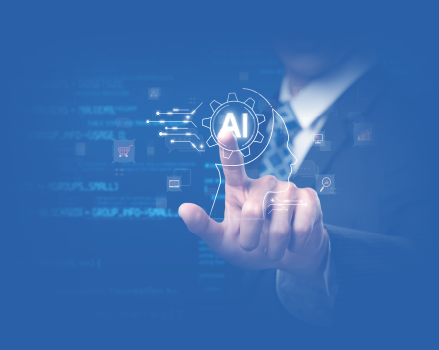
TL; DR

Understanding the types of AI agents is essential for businesses looking to automate, scale, and make smarter decisions.

Each of the top AI agents types—from reflex to learning agents—serves a specific function based on complexity and adaptability.

Choosing the right agent depends on the task—use different types of AI agents for prediction, personalization, or task execution.

Real-world adoption of types of AI agents for businesses is growing across industries like logistics, finance, healthcare, and retail.

Seeing types of AI agents with examples helps map the right solution to your specific business needs and environment.
AI agents are no longer experimental. They're already shaping how businesses operate across industries like finance, healthcare, logistics, and retail. From chatbots resolving support tickets to systems predicting equipment failure, AI agents are embedded in real operations.
But not all agents are built the same. Understanding the types of AI agents is essential for leaders investing in automation, decision-making, or customer experience. Some agents follow simple rules. Others learn and adapt. Some are built to complete tasks, while others support broader strategic goals.
This guide explains what are the main types of AI agents, how they function, and where they make the biggest impact. You'll get a practical breakdown of the core agent categories, along with types of AI agents with examples from real business scenarios. We'll also explore AI agent types based on functionality-like generative, predictive, and task-oriented agents.
Whether you're leading a product team, streamlining operations, or planning digital transformation, this guide will help you choose the right AI tools to move faster and build smarter.
At the core, an AI agent is a system that senses its environment, processes that input, and takes action to achieve a goal. It can be software, a physical machine, or a combination of both. What sets it apart is its ability to act with a degree of independence.
In business, AI agents show up in many forms. Some monitor user behavior on a website. Others flag anomalies in financial transactions. Some respond instantly; others process context before making a decision.
What defines an agent isn't just its function-but how it makes decisions. That's where types come in. From rule-based systems to learning models, different AI agents operate with different levels of complexity and autonomy.
Two factors typically shape the type of agent:
Understanding this helps leaders map the right type of AI agent to the right task-whether it's customer support, predictive maintenance, or demand forecasting.
Before diving into examples, let's break down the core types you'll come across.
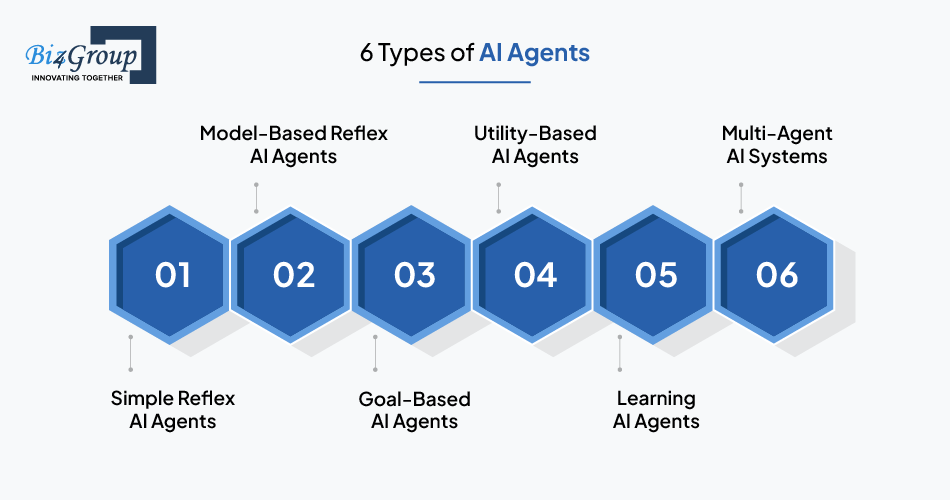
In this section, we'll break down the six core types of AI agents, each with its own decision-making model and business use case.
From simple reflexes to adaptive learning, understanding how these agents work will help you identify which type best fits your operational goals.
Simple reflex AI agents are the most basic form of AI agents. They respond directly to specific conditions in their environment-no memory, no learning, no context.
Think of them as rule-followers. If X happens, they do Y. The logic is fixed and immediate.
These agents operate using condition-action rules, often built around "if-then" logic. They don't store past information or analyze patterns. They act based solely on the current input they receive.
Simple reflex agents are well-suited for straightforward, repetitive tasks. You'll often see them in:
They can't adapt or improve. If a scenario changes or falls outside the preset rules, the agent won't know what to do.
These agents are useful for solving well-defined problems-but they hit a wall fast in dynamic environments.
Model-based reflex AI agents take a step beyond basic rule-following. Instead of reacting blindly, they use a model of the environment to inform their actions.
In short: they remember. And they adjust their responses based on what they know about the world around them.
These agents still rely on condition-action logic, but they also maintain an internal state. That internal model helps them track what's happening when not everything is directly visible. It fills in the gaps, using past input to interpret current situations.
Model-based reflex agents are helpful when decisions depend on more than just what's happening in the moment. You'll find them in:
They're smarter than simple agents-but still reactive. They don't pursue long-term goals or evaluate the best possible outcomes. They respond to what's happening, not what should happen.
Goal-based AI agents don't just react-they plan. These agents act with specific objectives in mind and choose actions that move them closer to a defined goal.
They're designed to ask: "What do I need to achieve?" and then decide, "What's the best move right now?"
Goal-based agents evaluate potential actions based on whether those actions help achieve a defined end state. This often involves decision trees, pathfinding, or even simulations to test different options before acting.
They need a clear goal to function. Without one, they have nothing to work toward.
Because of their flexibility, goal-based agents are ideal in environments where outcomes matter more than fixed rules. Common use cases include:
They rely heavily on accurate goal-setting and solid data. Poorly defined goals can lead to inefficient or unintended behavior. And they don't necessarily measure how well they're doing-just whether the goal is met.
Let’s help you turn business challenges into smart, AI-driven solutions that scale.
Schedule a Free ConsultationUtility-based AI agents don't just aim for a goal-they aim for the best possible outcome. These agents weigh multiple options and choose the one with the highest value based on a utility function.
In short, they ask: "What's the smartest decision I can make right now?"
These agents use a utility function to evaluate the desirability of different outcomes. Instead of just reaching a goal, they try to optimize for factors like speed, cost, safety, or customer satisfaction.
They consider trade-offs, prioritize outcomes, and aim to maximize benefit.
Utility-based agents are ideal for decision-heavy environments where not all outcomes are equal. You'll often see them in:
They require well-defined utility functions, which can be hard to design. If the function is off, the agent might prioritize the wrong outcomes. And they can be computationally heavy, especially in fast-changing environments.
Learning agents improve over time. They start with limited knowledge but adapt based on feedback, patterns, and experience. The more they operate, the smarter they get.
Instead of being hardcoded with rules, these agents figure things out as they go.
A learning agent typically includes four components:
It observes outcomes, refines its behavior, and adjusts its decisions based on what it learns from successes and failures.
Learning agents thrive in environments where change is constant and historical data is valuable. You'll see them in:
Learning can be slow, especially early on. These agents also need a feedback loop-without one, they can't improve. And depending on the use case, they can raise transparency or explainability concerns.
Not all AI agents work alone. In many business environments, systems are designed with multiple agents that interact, collaborate, or even compete to achieve broader objectives. These are known as multi-agent AI systems .
Each agent may have its own role, goal, and decision-making ability-but they operate as part of a larger network.
Multi-agent systems are made up of autonomous agents that communicate with each other. They can share data, negotiate actions, or divide tasks to solve complex problems collectively. Some work cooperatively; others operate independently but in shared environments.
Coordination, messaging protocols, and conflict resolution are key components of how these systems function effectively.
These systems shine in large-scale, distributed, or multi-faceted environments. Common examples include:
Coordination is complex. Agents may conflict, duplicate efforts, or cause bottlenecks if not well-orchestrated. Designing systems that align agent goals without central control can be challenging.
Also Read:30+ AI Agent Use Cases in 2025 for Every Industry [With Examples]
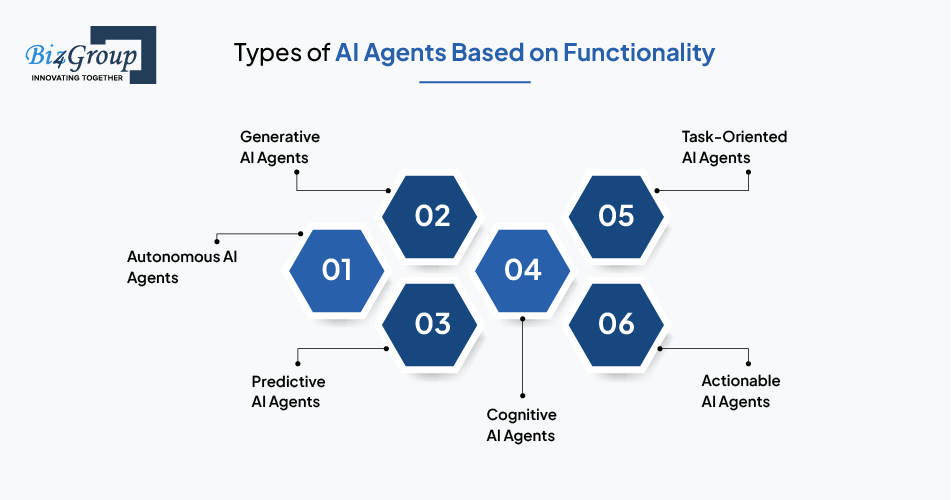
Beyond how they're built, AI agents can also be categorized by what they do. This lens focuses less on architecture and more on business application-how agents drive value across real-world use cases.
Understanding the different types of AI agents by functionality helps leaders choose tools that align with goals like automation, insight, or innovation. These classifications often overlap with agent types covered earlier, but they're framed around outcomes, not structure.
Let's explore the most common functional types of AI agents used in business today:
Autonomous AI agents are built to operate without human oversight. They observe, decide, and act in real time based on their goals and the environment around them.
These agents use sensors or data inputs to understand their surroundings. They're programmed with goals and rules for navigating toward them. Some operate using reinforcement learning, improving behavior through trial and feedback.
Generative AI agents are designed to create content. They use data to generate original outputs-text, images, video, code, even designs.
They're typically powered by large language or diffusion models. Given prompts or context, they generate content that matches tone, format, or structure. They don't just retrieve-they build.
These agents are forward-looking. Their job is to analyze patterns in data and make forecasts-often in real time.
They use historical data and machine learning models to detect patterns and predict outcomes. They don't just report trends-they anticipate what's likely to happen next.
From idea to deployment, we’ll guide you in building the right AI agent for your goals.
Start Your AI ProjectCognitive agents aim to mimic human thinking. They can interpret context, understand intent, and adapt based on conversation or interaction flow.
Often combining natural language processing (NLP), machine learning, and contextual memory, these agents hold more natural conversations or interpret nuanced information.
These are built to do one job-and do it well. They're not generalists. They execute defined tasks with speed and precision.
Task-oriented agents follow a narrow logic or workflow. They may involve automation scripts, rule-based flows, or machine learning tuned to a specific outcome.
Actionable agents don't just predict or inform-they initiate next steps. These agents are tightly integrated into workflows and trigger actions based on insights.
They monitor conditions or thresholds and automatically launch processes when specific triggers are met. This could mean updating records, sending alerts, or making real-time decisions.
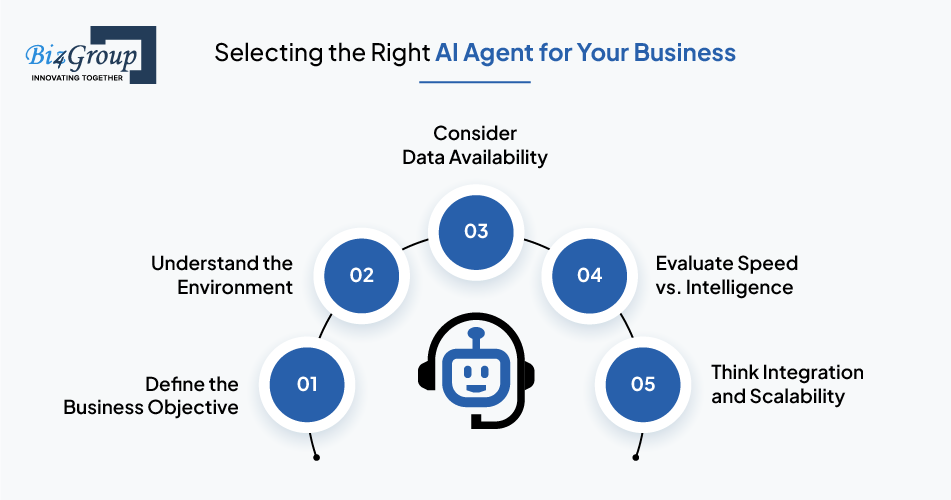
There's no one-size-fits-all when it comes to the best AI agents . The right choice depends on your business problem, environment complexity, and the outcomes you aim to achieve.
Here's how to break it down.
Start with the outcome, not the technology. Are you trying to speed up customer service? Reduce operational costs? Forecast demand more accurately? Different types of AI agents serve different goals.
Is your environment stable or constantly shifting? Are the rules clear, or does the system need to adapt?
No agent performs well without data. Some require large, labeled datasets (like learning agents). Others run efficiently with only a few input rules (like simple reflex agents).
Ask:
If speed and cost matter more than complexity, lean toward lightweight agents. If smarter decisions or adaptability matter more, go for learning or utility-based agents-even if they take longer to implement.
Choose agents that fit with your existing systems and can scale with your growth. Actionable agents, for example, need smooth integration with business tools like CRMs or ERPs.
Curious about the investment? We break down what it takes to build a top-tier AI agent.
Get a Custom Quote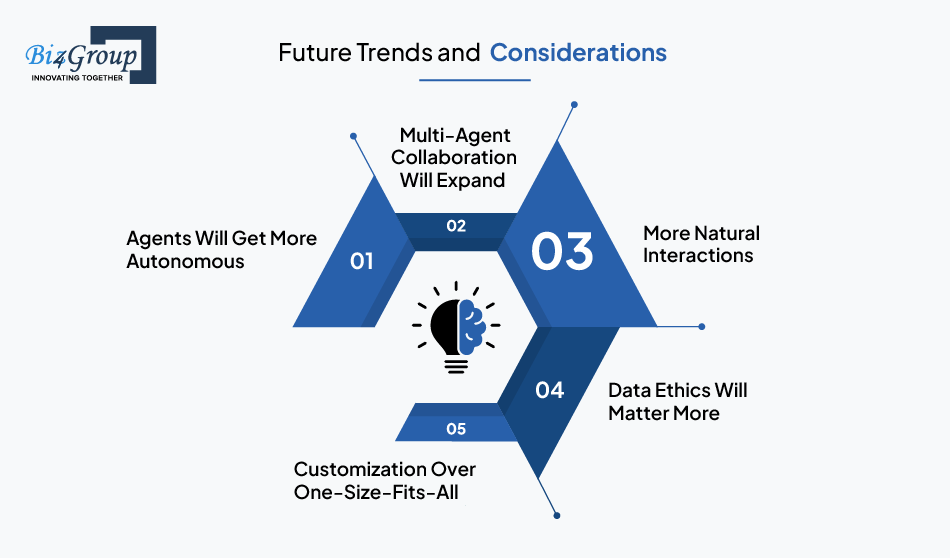
The landscape of AI is shifting quickly-and so are the expectations around how businesses use it. Understanding the types of AI agents today is essential, but knowing where they're headed is what sets leaders apart.
Here's what to watch as AI agents evolve in capability and impact:
AI agents are moving from assistive roles to autonomous decision-makers. In the near future, more systems will not just recommend actions-they'll take them, measure outcomes, and self-correct. Think proactive systems, not reactive tools.
Instead of one smart tool, businesses will deploy networks of agents-each with a specialty, all working together. Expect greater use of multi-agent systems, especially in logistics, finance, and smart infrastructure.
Cognitive and generative agents are making AI feel more human. We're already seeing voice-based interfaces, emotionally aware chatbots, and agents that adapt tone and context. These systems will blur the line between tool and teammate.
As agents get smarter and more involved in decisions, businesses will face greater scrutiny. Transparency, fairness, and explainability won't just be nice-to-haves-they'll be regulatory requirements. Leaders will need to ensure agents act responsibly.
Pretrained models and off-the-shelf solutions will still play a role, but more businesses will invest in tailored AI agents designed around their unique data, goals, and workflows.
Understanding the types of AI agents is the first step. The next is turning that understanding into a real, working solution-one that fits your business, scales with your needs, and delivers measurable results.
That's where Biz4Group comes in.
As a trusted AI agent development company , we specialize in building intelligent, purpose-driven agents tailored to your specific goals. Whether you need a predictive engine for better forecasting, a generative agent for marketing automation, or a multi-agent system to orchestrate complex workflows-we build solutions that make sense for your world.
We don't just deploy code. We help you define the right type of AI agent for the job, align it with your systems, and ensure it drives real business value from day one.
Curious about the investment involved? Explore our breakdown on AI agent development cost to see what goes into building, training, and scaling an intelligent system built for impact.
You can also explore our latest AI agent projects to see how we're helping businesses like yours bring intelligent solutions to life.
Not sure which AI agent fits your needs? Our experts will help you decide—no guesswork.
Book an AppointmentAs you explored the types of AI agents, it's clear that each serves a unique role-from reactive tools to intelligent, goal-driven systems. These agents aren't just concepts-they're being applied across industries to solve real business challenges.
This guide covered the top AI agents types, how they function, and where they deliver value. You've seen practical types of AI agents with examples that highlight their role in automation, forecasting, personalization, and more.
For businesses, the key isn't adopting every innovation-it's selecting the right agent for the right use case. When done right, the right types of AI agents for businesses can unlock speed, scale, and smarter decision-making.
Now you're equipped to make more informed choices as you integrate AI into your business strategy.
Looking to build your own AI agent ? Let's talk.
The main types include Simple Reflex, Model-Based Reflex, Goal-Based, Utility-Based, Learning Agents, and Multi-Agent Systems. Each serves a specific level of intelligence, from basic reactions to strategic decision-making.
Task-oriented or reflex agents are ideal for rule-based automation. They handle repetitive processes quickly and reliably, without needing to learn or adapt.
Start by defining your goal-automation, prediction, or decision-making. Then choose an agent type that matches your environment, available data, and desired outcome.
Yes, autonomous AI agents can operate without direct oversight. They're designed to make decisions and act independently, especially in predictable or well-structured environments.
Absolutely. Generative AI agents can create content, automate creative tasks, and enhance personalization-making them valuable in marketing, eCommerce, and product development.
IN YOUR BUSINESS FOR FREE
Our website require some cookies to function properly. Read our privacy policy to know more.